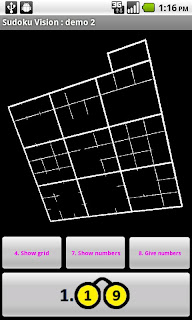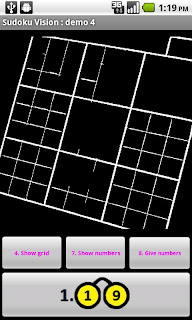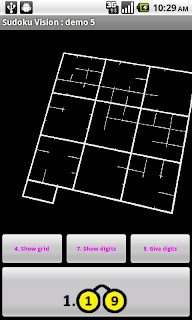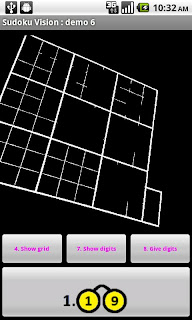We have to find the grid in the binary image (black and white image). A very simple way to do that is to use an algorithm for region marking using flood filling. It is amazing how it takes so few lines of Java code to find the largest region which is, by the way, the grid.
- Recursive version
- Depth-First version : we use this version
- Breadth-First version
You can see the Java code of chapter 11 here :
Java code of chapter 11 to find regions in binary images
Again, really a great book!
We will execute the same algorithm to find the numbers later.
You can find a piece of pseudo-code below.
Here are the screen shots of the same photos we get after flood filling :
Pseudo-code
The definition of I is
the same as the one on page 200.
Here is the
pseudo-code to label all the regions and to identify the largest one:
label = 2
label_ max = 0 // to keep the label of the largest region
label_ max = 0 // to keep the label of the largest region
masse_max = 0 // to
help to identify the largest region
// label all the regions
for each (x, y) of I
if (I(x,y) == 1)
masse = 0
floodfill(x,
y)
if
(masse > masse_max)
masse_max = masse
label_
max = label // keep the label of the
largest region
label++
// identify the
largest region with 1 and all the others regions with 0
for each (x, y) of I
if I(x,y) == label_max
I(x,y) = 1
else
I(x,y) = 0
Here is the
pseudo-code for floodfill(x,y) : depth-first version is used
// We do not use object to improve performance
pile[2][100000] // this is
the array representing the stack
// We use pile[2][100000]
instead of pile[100000][2] to use less memory :
// memory taken by pile[2][100000] = 2 * 16 + 2
* 100000 * 4 = 800 032 bytes
// memory taken by pile[100000][2] = 100000 *
16 + 2 * 100000 * 4 = 2 400 000 bytes
// where 16 is the typical overhead for each line of the array
// where 16 is the typical overhead for each line of the array
pile[0][0] = x
pile[1][0] = y
pile_i = 1
pile_n =
pile[0].length
// width is width of I : it is 512 for the application
// height is height of I : it is 512 for the application
// width is width of I : it is 512 for the application
// height is height of I : it is 512 for the application
while (pile_i != 0)
pile_i--
x = pile[0][pile_i]
y = pile[1][pile_i]
if (I[x][y] == 1)
I[x][y] = label
masse++
if (x + 1
< width && I[x + 1][y] == 1) {
pile[0][pile_i]
= x + 1
pile[1][pile_i]
= y
pile_i++
if
(pile_i >= pile_n)
return
}
if (y + 1
< height && I[x][y + 1] == 1) {
pile[0][pile_i]
= x
pile[1][pile_i]
= y + 1
pile_i++
if
(pile_i >= pile_n)
return
}
if (y - 1
>= 0 && I[x][y - 1] == 1) {
pile[0][pile_i]
= x
pile[1][pile_i]
= y - 1
pile_i++
if
(pile_i >= pile_n)
return
}
if (x - 1
>= 0 && I[x - 1][y] == 1) {
pile[0][pile_i]
= x - 1
pile[1][pile_i]
= y
pile_i++
if
(pile_i >= pile_n)
return
}
if (x - 1
>= 0 && y - 1 >= 0 && I[x - 1][y - 1] == 1) {
pile[0][pile_i]
= x - 1
pile[1][pile_i]
= y - 1
pile_i++
if
(pile_i >= pile_n)
return
}
if (x + 1
< width && y - 1 >= 0 && I[x + 1][y - 1] == 1) {
pile[0][pile_i]
= x + 1
pile[1][pile_i]
= y - 1
pile_i++
if
(pile_i >= pile_n)
return
}
if (x - 1
>= 0 && y + 1 < height && I[x - 1][y + 1] == 1) {
pile[0][pile_i]
= x - 1
pile[1][pile_i]
= y + 1
pile_i++
if
(pile_i >= pile_n)
return
}
if (x + 1
< width && y + 1 < height && I[x + 1][y + 1] == 1) {
pile[0][pile_i]
= x + 1
pile[1][pile_i]
= y + 1
pile_i++
if
(pile_i >= pile_n)
return
}
I hope it helps.






Hi Rogerlebo,
ReplyDeleteThank you for sharing your knowledge, could you please share the source code of this section. I don't know exactly, which section of chapter 11 do you use?!
Hi!
ReplyDeleteA piece of pseudo-code is now presented.
I hope it helps.
Bonne journée!
Thank you so much, it helps a lot :)
Delete